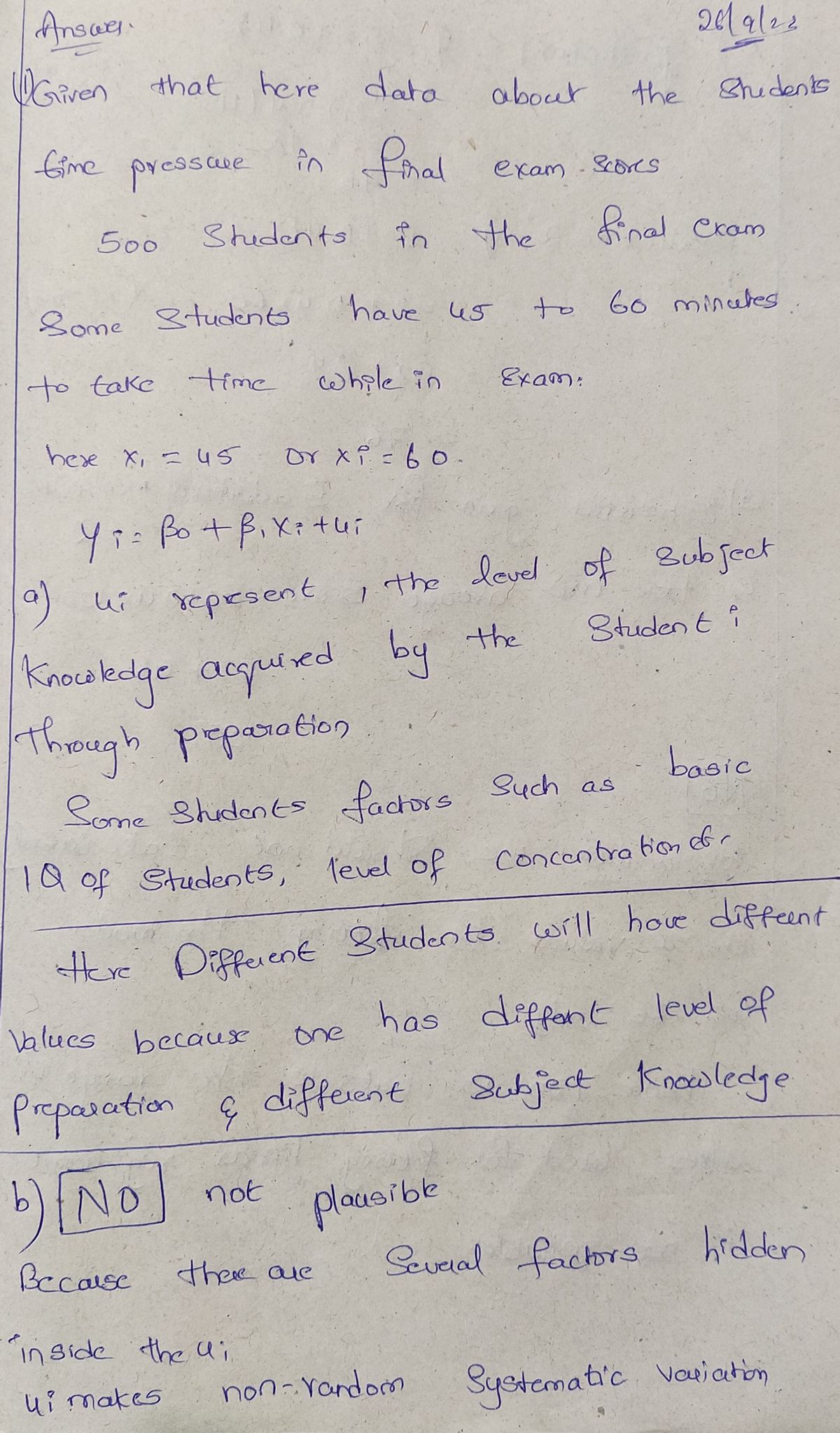(1) (modified from Stock and Watson Exercise 4.5) A professor decides to run an experiment to measure the effect of time pressure on final exam scores. She gives each of the 500 students in her course the same final exam, but some students have 45 minutes to complete the exam while others have 60 minutes. Each student is randomly assigned one of the examination times based on the flip of a coin. Let Y, denote the number of points (out of 100) scored on the exam by the ith student (i = 1, ..., 500), and let X¿ be the amount of minutes that the student had to complete the exam (so X₁ = 45 or X₂ = 60). Consider the linear regression model Y = Bo + BıXi+uj . (a) Explain what the term u, represents here. Why will different students have different values of ui? (b) Is it plausible to assume that E(u₁|X;) briefly. = 0 in this setting? Explain (c) Suppose the estimated regression line is Ỹ; = 52+0.4X₁. Compute the predicted score of a student that was given 45 minutes to complete the exam. Repeat for 60 minutes. (d) Based on the estimates in part (c), compute the estimated gain in score for a student who is given an additional 10 minutes on the exam. (e) Suppose the university administration would consider a policy change that requires all exams to take 120 minutes. What would the estimates in (c) literally suggest happens to students' average scores in this case?
(1) (modified from Stock and Watson Exercise 4.5) A professor decides to run an experiment to measure the effect of time pressure on final exam scores. She gives each of the 500 students in her course the same final exam, but some students have 45 minutes to complete the exam while others have 60 minutes. Each student is randomly assigned one of the examination times based on the flip of a coin. Let Y, denote the number of points (out of 100) scored on the exam by the ith student (i = 1, ..., 500), and let X¿ be the amount of minutes that the student had to complete the exam (so X₁ = 45 or X₂ = 60). Consider the linear regression model Y = Bo + BıXi+uj . (a) Explain what the term u, represents here. Why will different students have different values of ui? (b) Is it plausible to assume that E(u₁|X;) briefly. = 0 in this setting? Explain (c) Suppose the estimated regression line is Ỹ; = 52+0.4X₁. Compute the predicted score of a student that was given 45 minutes to complete the exam. Repeat for 60 minutes. (d) Based on the estimates in part (c), compute the estimated gain in score for a student who is given an additional 10 minutes on the exam. (e) Suppose the university administration would consider a policy change that requires all exams to take 120 minutes. What would the estimates in (c) literally suggest happens to students' average scores in this case?
MATLAB: An Introduction with Applications
6th Edition
ISBN:9781119256830
Author:Amos Gilat
Publisher:Amos Gilat
Chapter1: Starting With Matlab
Section: Chapter Questions
Problem 1P
Related questions
Question

Transcribed Image Text:(1) (modified from Stock and Watson Exercise 4.5) A professor decides to run
an experiment to measure the effect of time pressure on final exam scores.
She gives each of the 500 students in her course the same final exam, but
some students have 45 minutes to complete the exam while others have 60
minutes. Each student is randomly assigned one of the examination times
based on the flip of a coin. Let Y; denote the number of points (out of
100) scored on the exam by the ith student (i = 1, ..., 500), and let X¿
be the amount of minutes that the student had to complete the exam (so
X₁ = 45 or X₂ = 60). Consider the linear regression model
Y = Bo + BıXi+uj .
(a) Explain what the term u, represents here. Why will different students
have different values of ui?
(b) Is it plausible to assume that E(u₁|X;)
briefly.
=
0 in this setting? Explain
(c) Suppose the estimated regression line is ο 52+0.4X₁. Compute the
predicted score of a student that was given 45 minutes to complete the
exam. Repeat for 60 minutes.
(d) Based on the estimates in part (c), compute the estimated gain in score
for a student who is given an additional 10 minutes on the exam.
(e) Suppose the university administration would consider a policy change
that requires all exams to take 120 minutes. What would the estimates
in (c) literally suggest happens to students' average scores in this case?
Should we take this prediction seriously? Why or why not?
Expert Solution
Step 1

Trending now
This is a popular solution!
Step by step
Solved in 2 steps with 2 images






